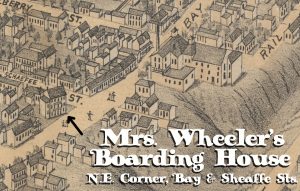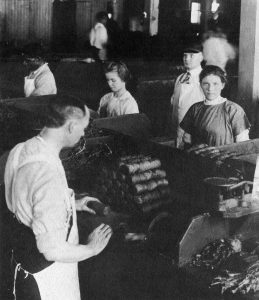Families at Work and at Home
Changes in the workplace also brought changes to the lives of working families. Women at home were often unwaged workers, who gardened and preserved vegetables or raised pigs and chickens to help provide for their families. This was so common that, by 1891, there were twice as many chickens as people in the North-End of Hamilton.
Women – and sometimes girls – also began to work outside of the home, becoming a common sight on the shop floors of the city’s boot and shoe factories, tobacco plants, and recently opened textile mills. Young, single women often worked in the new manufactories for a few years before they got married. Their wages supplemented the low incomes of other family members. Once married, most women returned to the home, but some brought in piecemeal sewing and other work to supplement the household income. The McMahon family was the perfect example; with her husband, John, working for the Great Western Railway but unable to support their four children under the age of six, Bessie McMahon brought in seamstress home work to help make ends meet.

Mrs. Wheeler’s Boarding House provided lodging for a number of Great Western Railway employees who became involved in the Nine-Hour League.
Taking in boarders could also provide extra income, especially for the many families who lost their fathers to unsafe working conditions. After she was widowed, Mrs. Wheeler opened a boarding house on Bay Street North. By 1872, the house was home to 19 men, including James Ryan, James Ballantyne, and Silas Wheeler – three key participants in the Nine-Hour Movement.


